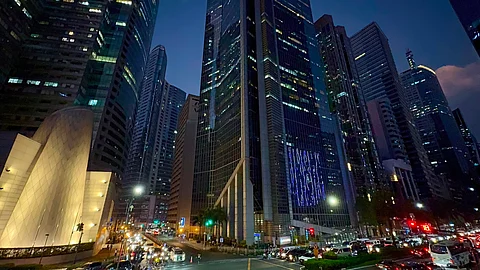
- NEWS
- the EDIT
- COMMENTARY
- BUSINESS
- LIFE
- SHOW
- ACTION
- GLOBAL GOALS
- SNAPS
- DYARYO TIRADA
- MORE

The country’s economy could expand by 5.5 percent this year and 5.6 percent in 2026 due to looser monetary policy and slower foreign direct investments, according to analysis by the Institute of International Finance (IIF).
The Philippine outlook for 2025 is the second best among seven countries in Asia, trailing behind India’s 6.2 percent but surpassing Indonesia’s and China’s 4.7 percent. The other countries in the IIF report are Malaysia (3.6 percent), Thailand (1.8 percent), and South Korea (0.7 percent).
For next year, Philippine economic growth is again seen to grow the second fastest, after India’s 6.8 percent, but ahead of Indonesia and Malaysia, at 5.2 percent.
“We expect monetary easing and fiscal policy to play an important role in mitigating downside growth risks from Trump’s tariffs,” IIF said.
The IIF said the Bangko Sentral ng Pilipinas could ease its policy rate to lenders ahead of the United State’s Federal Reserve to drive faster economic growth through stronger domestic consumption of goods and services while demand for exports weakens.
Inflation slows down to 1.3 percent
Such analysis by the IIF came after Philippine inflation again slowed to 1.3 percent in May, resulting in an average of 1.9 percent over the first five months of the year, according to the Philippine Statistics Authority. Both figures fell below the Bangko Sentral ng Pilipinas’ minimum target of 2 percent.
“Inflation across the region has largely come down to or below targets,” the IIF said.
“US tariffs are also expected to have a disinflationary effect on the region by dampening export demand,” it added.
Local household consumption in the first quarter of this year accelerated by 5.3 percent from 4.6 percent in the same quarter of 2024, after the Central Bank cut its policy rate by a total of 75 basis points last year to 5.75 percent in December from 6.5 percent in May.
Slower exports, FDI
However, IIF said the country and the rest of emerging markets (EM) in Asia might register less foreign direct investments (FDI) this year as economic uncertainties from Trump’s tariffs linger.
The IIF said EM Asia excluding China might attract a lower average FDI inflows of $90 billion this year.
“There are early signs that global portfolio allocations have turned less favorable for US assets amid a weaker dollar and high equity valuations, but EM Asia might benefit less this time, given lingering tariffs uncertainties and elevated long term US interest rates,” the IIF said.
US President Donald Trump announced a 17 percent tariff on the Philippines. However, he gave governments until 9 July to negotiate trade deals with the US in minimizing the domestic economic impact of higher tariffs on US imports.
However, Trump on Friday said he could either shorten or extend that deadline. “We can do whatever we want,” he told the media at the White House.
US trade uncertainty policy index
he US trade uncertainty policy index has also surged from the 1,000 recorded in 1994 to nearly 6,000.
Economists warned that global inflation might increase if the US imposes a high tariff on China, the world’s manufacturing powerhouse, through passed-on costs to consumers.
“A trade deal between the US and China avoiding punitive tariffs, combined with a strong stimulus package by the Chinese government, would be a positive catalyst for capital flows to Asia, as it would reduce negative risks around Asia’s growth and inflation outlook,” IIF said.
While the US imposes a baseline tariff of 10 percent on all foreign goods, US Treasury Secretary Scott Bessent on Friday said Chinese goods will be levied a minimum tariff of 30 percent, much lower than the initial 145 percent. Meanwhile, China will impose a 10 percent tax on US imports.
“With much of Asia highly open to international trade, a minimum tariff level imposed by the United States remains the key downside drag to growth,” the IIF said.
Under the 10 percent baseline tariff, Chinabank on Friday said that Philippine exports to the US declined by 3.6 percent in May from 5.9 percent in April.
